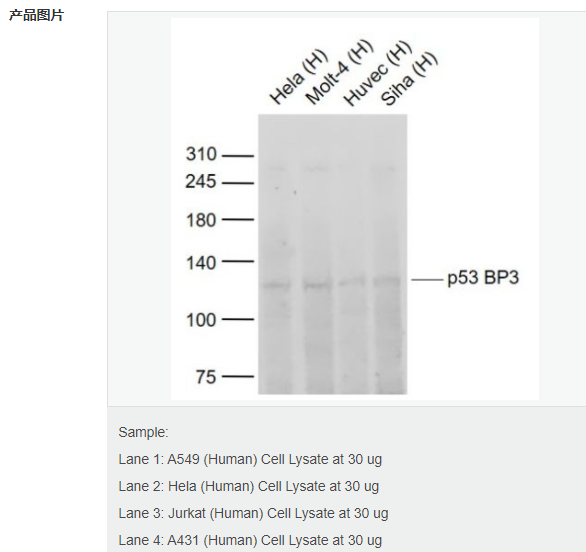
货号
产品规格
售价
备注
BN40656R-100ul
100ul
¥2360.00
交叉反应:Human(predicted:Mouse,Rat,Dog,Pig,Cow,Horse,Rabbit,Sheep) 推荐应用:WB
BN40656R-200ul
200ul
¥3490.00
交叉反应:Human(predicted:Mouse,Rat,Dog,Pig,Cow,Horse,Rabbit,Sheep) 推荐应用:WB
| 英文名称 | p53 BP3 |
| 中文名称 | p53结合蛋白3抗体 |
| 别 名 | AW105885; E3 ubiquitin protein ligase Topors; E3 ubiquitin-protein ligase Topors; LUN; p53 binding protein 3; p53 BP3/LUN; p53-binding protein 3; p53BP3; p53BP3/LUN; Retinitis pigmentosa 31; RP31; SUMO1 protein E3 ligase Topors; SUMO1-protein E3 ligase Topors; Topoisomerase I binding arginine/serine rich; Topoisomerase I binding arginine/serine rich protein; Topoisomerase I binding protein; Topoisomerase I binding RING finger protein; Topoisomerase I-binding arginine/serine-rich protein; Topoisomerase I-binding RING finger protein; Topoisomerase I-binding RS protein; TOPORS; TOPRS_HUMAN; TP53BPL; Tumor protein p53 binding protein; Tumor suppressor p53 binding protein 3; Tumor suppressor p53-binding protein 3. |
| 研究领域 | 肿瘤 细胞生物 细胞周期蛋白 表观遗传学 泛素 |
| 抗体来源 | Rabbit |
| 克隆类型 | Polyclonal |
| 交叉反应 | Human, (predicted: Mouse, Rat, Dog, Pig, Cow, Horse, Rabbit, Sheep, ) |
| 产品应用 | WB=1:500-2000 not yet tested in other applications. optimal dilutions/concentrations should be determined by the end user. |
| 分 子 量 | 119kDa |
| 细胞定位 | 细胞核 |
| 性 状 | Liquid |
| 浓 度 | 1mg/ml |
| 免 疫 原 | KLH conjugated synthetic peptide derived from human p53 BP3:21-120/1045 |
| 亚 型 | IgG |
| 纯化方法 | affinity purified by Protein A |
| 储 存 液 | 0.01M TBS(pH7.4) with 1% BSA, 0.03% Proclin300 and 50% Glycerol. |
| 保存条件 | Shipped at 4℃. Store at -20 °C for one year. Avoid repeated freeze/thaw cycles. |
| PubMed | PubMed |
| 产品介绍 | This gene encodes a nuclear protein which is serine and arginine rich, and contains a RING-type zinc finger domain. It is highly expressed in the testis, and functions as an ubiquitin-protein E3 ligase. Mutations in this gene are associated with retinitis pigmentosa type 31. Alternatively spliced transcript variants, encoding different isoforms, have been observed for this locus. [provided by RefSeq, Sep 2010] Function: Functions as an E3 ubiquitin-protein ligase and as an E3 SUMO1-protein ligase. Probable tumor suppressor involved in cell growth, cell proliferation and apoptosis that regulates p53/TP53 stability through ubiquitin-dependent degradation. May regulate chromatin modification through sumoylation of several chromatin modification-associated proteins. May be involved in DNA damage-induced cell death through IKBKE sumoylation. Subcellular Location: Nucleus. Nucleus > PML body. Localizes to discrete nuclear foci which partly overlap with PML nuclear bodies. Targeted to PML nuclear bodies upon DNA damage. Tissue Specificity: Expressed at highest levels in testis and at lower levels in adrenal gland, bone marrow, brain, colon, heart, kidney, liver, muscle, ovary, pancreas, placenta, prostate, skeletal muscle, skin, small intestine, spleen, stomach, testis, thymus, thyroid and uterus. Expressed in the alveolar epithelium of the lung. Expression is commonly decreased in colon adenocarcinomas and lung cancers. Post-translational modifications: Phosphorylation at Ser-98 regulates the E3 ubiquitin-protein ligase activity but not the SUMO1-protein ligase activity. Phosphorylation at Ser-718 increases the E3 ubiquitin-protein ligase activity versus the SUMO1-protein ligase activity resulting in increased p53/TP53 ubiquitination and degradation. Sumoylated. DISEASE: Defects in TOPORS are the cause of retinitis pigmentosa type 31 (RP31) [MIM:609923]. RP leads to degeneration of retinal photoreceptor cells. Patients typically have night vision blindness and loss of midperipheral visual field. As their condition progresses, they lose their far peripheral visual field and eventually central vision as well.RP31 inheritance is autosomal dominant. Similarity: Contains 1 RING-type zinc finger. SWISS: Q9NS56 Gene ID: 10210 Database links: Entrez Gene: 10210 Human Omim: 609507 Human SwissProt: Q9NS56 Human Unigene: 589962 Human Important Note: This product as supplied is intended for research use only, not for use in human, therapeutic or diagnostic applications. |
